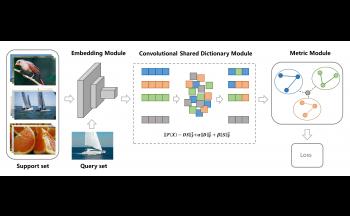
Few-shot learning is the most prevalent problem which has attracted lots of attention in recent years. It is a powerful research method in the case of limited training data. Simultaneously, few-shot learning methods based on metric learning mainly measure the similarity of feature embeddings between the query set sample and each class of support set samples. Therefore, how to design a CNN-based feature extractor is the most crucial problem. Nowadays, the existed feature extractors are obtained via training the standard convolutional networks (e.g., ResNet), which merely focuses on the information inside each image. However, the relations among samples may also be beneficial to promote the performance of the few-shot learning task. This paper proposes a Convolutional Shared Dictionary Module (CSDM) to find the hidden structural information among samples for few-shot learning and reduce the dimension of sample features to remove redundant information. Therefore, the learned dictionary is more easily adapt to the novel class, and the reconstructed features are more discriminative. Moreover, the CSDM is a plug-and-play module and integrates the dictionary learning algorithm into the feature embedding. Experimental results on several benchmark datasets have demonstrated the effectiveness of the proposed CSDM.

Nowadays, digital images are used as critical evidence for judgment, but they can be forged using image processing tools with invisible traces and little effort. Hence, it is very important to determine the authenticity of these digital images. In this paper, we propose a novel approach that uses dictionary learning and sparse coding to detect digital image forgery. We experimented with two popular data sets to determine how effectively and efficiently our approach detects digital image forgery compared to previous approaches. The results show that our approach not only outperforms these approaches in terms of Precision, Recall, and F1 score, but it is also more robust against compression and rotation attacks. Also, our approach detects forgery significantly faster than previous approaches since it uses a sparse representation that dramatically reduces the feature dimensionality by a factor of more than 20.